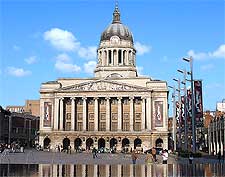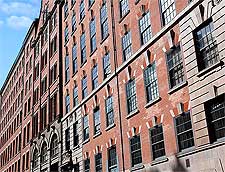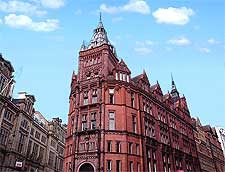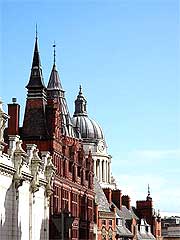Nottingham History Facts and Timeline
(Nottingham, Nottinghamshire, England)

The city of Nottingham started out life as a 6th-century Saxon village. History shows that it was originally known as 'Snotta inga ham', which means 'the village belonging to Snotta'.
The city's location at a crossing point on the River Trent made it an attractive proposition for many potential settlers, including the Danes. In the late 9th century AD, they took control of Nottingham, fortifying it with a rampart and palisade. A century later, the Anglo-Saxons recaptured Nottingham and built a bridge across the river.
Medieval Times
By the arrival of William the Conqueror in 1067, Nottingham had grown into a bustling town and a wooden castle was quickly built to defend the city. A new town, mostly inhabited by French Normans, was also created alongside the old town. Both boroughs were, for a time, separately administered.

During the 13th and 14th centuries, the castle was renovated and its wooden structure replaced by stone walls. Medieval Nottingham had its own Charter, its own mayor, and a weekly market and annual fair.
Many of the townsfolk were engaged in wool making, brewing, shoemaking and carpentry. Religious orders, such as the Franciscans and Carmelites, lived here, as did a Jewish community until the end of the 13th century. It's from the 14th century that the legend of Robin Hood is thought to date. Whether or not the town or sheriff in this tale actually relate to Nottingham is still hotly debated.

Early Modern History
By the late 17th century, the city had a vibrant silk and hosiery industry. It was also a centre for the malting industry. Nottingham continued to grow, and by the time of the English Civil War in the mid-17th century, around 5,000 people lived here. The city was occupied by Parliamentarian troops from November 1642, despite attempts by the Royalist army to attack.
At the end of the war, Parliament ordered the destruction of Nottingham Castle to save it from falling into Royalist hands in the future. Then, in 1674, the Duke of Newcastle bought the site and built a mansion here. During the remainder of the 17th and 18th centuries, Nottingham fared well. By the 1760s, its streets were lit by oil lamps and the well-to-do could enjoy visiting the city's new theatre.

Victorian Times to the 20th Century
In the middle of the 19th century, the release of new land for building meant that the city could meet growing demand for housing. It was sorely needed, since living conditions were hard at this time, with successive outbreaks of disease in the city, including cholera in 1833. Gradually, however, Victorian innovations brought better conditions. These included building public parks and, in 1868, the city's first public library. In the 1860s, two new football teams were founded - Nottingham County FC and Nottingham Forest.
Whilst the city's links with the hosiery industry continued, a new lace-making industry also grew up here. So too did a bicycle manufacturing business. It was soon manufacturing thousands of bikes every year, under the name of Raleigh.
In 1897, Nottingham was finally given city status. It marked a new era in the city's history. Between 1901 and 1936, electric trams ran through its streets. By 1928, the city had its own Lord Mayor. Between 1948 and the 1960s, developments included a new university, Clifton Bridge, the Victoria Bus Station and the Playhouse Theatre. The city continues to thrive and, in 2004, the sound of trams could once again be heard in the streets.
 The city of Nottingham started out life as a 6th-century Saxon village. History shows that it was originally known as 'Snotta inga ham', which means 'the village belonging to Snotta'.
The city of Nottingham started out life as a 6th-century Saxon village. History shows that it was originally known as 'Snotta inga ham', which means 'the village belonging to Snotta'. During the 13th and 14th centuries, the castle was renovated and its wooden structure replaced by stone walls. Medieval Nottingham had its own Charter, its own mayor, and a weekly market and annual fair.
During the 13th and 14th centuries, the castle was renovated and its wooden structure replaced by stone walls. Medieval Nottingham had its own Charter, its own mayor, and a weekly market and annual fair.
